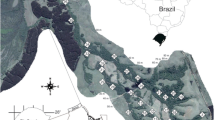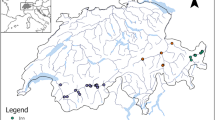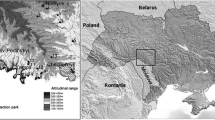Abstract
What environmental variables determine riparian vegetation patterns? Are there differences between woody and herbaceous species? To answer these questions, we first explored the composition and richness patterns of both riparian woody and herbaceous species in a semi-arid mediterranean basin. Then, we assessed the environmental factors (climate, geology, topography, hydrogeomorphology and land use) that best explain these patterns. We used the following methodological approaches: clustering analyses, distance-based linear models, generalised linear models and hierarchical partitioning procedures. Valley shape, drought duration, river habitat heterogeneity, water conductivity and agricultural land use were the most important variables explaining variation in species composition for both groups. Woody riparian richness was mainly influenced by flow conditions and valley shape, whereas herbaceous one was more dependent on substrate features. Thus, although some differences in the importance of individual variables were observed, we found a notable congruence in the composition and species richness of both groups and also in the main types of variables explaining these patterns (hydrogeomorphology and land use, especially agriculture). Our results show that both communities could be treated in a holistic way, since they respond similarly to the strong natural and anthropogenic environmental gradients present in mediterranean basins.



Similar content being viewed by others
References
Aguiar, F. C. & M. T. Ferreira, 2005. Human-disturbed landscapes: effects on composition and integrity of riparian woody vegetation in the Tagus River basin, Portugal. Environmental Conservation 32: 30–41.
Aguiar, F. C., M. T. Ferreira & A. Albuquerque, 2006. Patterns of exotic and native plant species richness and cover along a semi-arid Iberian river and across its floodplain. Plant Ecology 184: 189–202.
Aguiar, F. C., M. T. Ferreira, A. Albuquerque, P. Rodríguez-González & P. Segurado, 2009. Structural and functional responses of riparian vegetation to human disturbance: performance and spatial scale-dependence. Fundamental and Applied Limnology/Archiv für Hydrobiologie 175: 249–267.
Alcaraz, F., S. Ríos, C. Inocencio & A. Robledo, 1997. Variation in the riparian landscape of the Segura River Basin, SE Spain. Journal of Vegetation Science 8: 597–600.
Allan, J. D., 2004. Landscapes and riverscapes: the influence of land use on stream ecosystems. Annual Review of Ecology, Evolution, and Systematics 35: 257–284.
Anderson, M. J., R. N. Gorley & K. R. Clarke, 2008. PERMANOVA + for PRIMER: Guide to Software and Statistical Methods. PRIMER-E, Plymouth.
Baker, W. L., 1989. Macro- and micro-scale influences on riparian vegetation in Western Colorado. Annals of the Association of American Geographers 79: 65–78.
Belmar, O., J. Velasco, C. Gutiérrez-Cánovas, A. Mellado-Díaz, A. Millán & P. J. Wood, 2012. The influence of natural flow regimes on macroinvertebrate assemblages in a semiarid mediterranean basin. Ecohydrology 6: 363–379.
Belmar, O., D. Bruno, F. Martínez-Capel, J. Barquín & J. Velasco, 2013. Effects of flow regime alteration on fluvial habitats and riparian quality in a semiarid mediterranean region. Ecological Indicators 30: 52–64.
Benda, L., D. Miller, K. Andras, P. Bigelow, G. Reeves & D. Michael, 2007. NetMap: A new tool in support of watershed science and resource management. Forest Science 53: 206–219.
Brinson, M. M. & J. Verhoeven, 1999. Riparian forests. In Hunter Jr, M. L. (ed.), Maintaining Biodiversity in Forest Ecosystems. Cambridge University Press, New York: 265–299.
Carbonell, J. A., C. Gutiérrez-Cánovas, D. Bruno, P. Abellán, J. Velasco & A. Millán, 2011. Ecological factors determining the distribution and assemblages of the aquatic Hemiptera (Gerromorpha and Nepomorpha) in the Segura river basin (Spain). Limnetica 30: 59–70.
Casas, J. J., M. O. Gessner, P. H. Langton, D. Calle, E. Descals & M. J. Salinas, 2006. Diversity of patterns and processes in rivers of eastern Andalusia. Limnetica 25: 155–170.
Chevan, A. & M. Sutherland, 1991. Hierarchical partitioning. The American Statistician 45: 90–96.
Clarke, K. R. & R. N. Gorley, 2006. PRIMER v6: User Manual/Tutorial. PRIMER-E, Plymouth.
Clarke, K. R., P. J. Somerweld & R. N. Gorley, 2008. Testing of null hypotheses in exploratory community analyses: similarity profiles and biota-environment linkage. Journal of Experimental Marine Biology and Ecology 366: 56–69.
Confederación Hidrográfica del Segura (CHS), 2007. Estudio General sobre la Demarcación Hidrográfica del Segura. Confederación Hidrográfica del Segura, Murcia.
Décamps, H. & E. Tabacchi, 1994. Species richness in vegetation along river margins. In Giller, P. S., A. G. Hildrew & D. G. Raffaelli (eds), Aquatic Ecology, Scale, Pattern and Process. Blackwell, Oxford: 1–20.
Douma, J. C., V. Bardin, R. P. Bartholomeus & P. M. Bodegom, 2012. Quantifying the functional responses of vegetation to drought and oxygen stress in temperate ecosystems. Functional Ecology 26: 1355–1365.
Estrela, T., F. Cabezas & F. Estrada, 1999. La evaluación de los recursos hídricos en el Libro Blanco del Agua en España. Ingeniería del Agua 6: 125–138.
European Commission, 2009. Regions 2020. The climate change challenge for European regions http://ec.europa.eu/regional_policy/sources/docoffic/working/regions2020/pdf/regions2020_climat.pdf. Accessed 1 June 2013.
Ferreira, M. T. & F. C. Aguiar, 2006. Riparian and aquatic vegetation in mediterranean-type streams (western Iberia). Limnetica 25: 411–424.
Ferreira, M. T. & I. S. Moreira, 1999. River plants from an Iberian basin and environmental factors influencing their distribution. Hydrobiologia 415: 101–107.
Garófano-Gómez, V., F. Martinez-Capel, M. Peredo-Parada, E. J. Olaya-Marín, R. Muñoz-Mas, R. M. Soares-Costa & J. L. Pinar-Arenas, 2011. Assessing hydromorphological and floristic patterns along a regulated mediterranean river: the Serpis river (Spain). Limnetica 30: 307–328.
Gasith, A. & V. H. Resh, 1999. Streams in mediterranean climate regions: abiotic influences and biotic responses to predictable seasonal events. Annual Review of Ecology and Systematics 30: 51–81.
Gauch, H. G., 1982. Multivariate Analysis in Community Ecology. Cambridge University Press, Cambridge.
Giorgi, F. & P. Lionello, 2008. Climate change projections for the mediterranean region. Global and Planetary Change 63: 90–104.
Gregory, S. V., F. J. Swanson, W. A. McKee & K. W. Cummins, 1991. An ecosystem perspective of riparian zones. BioScience 41: 540–551.
Grime, J. P., 1979. Plant Strategies and Vegetation Processes. Wiley, New York.
Lite, S. J., K. J. Bagstad & J. C. Stromberg, 2005. Riparian plant species richness along lateral and longitudinal gradients of water stress and flood disturbance, San Pedro River, Arizona, USA. Journal of Arid Environments 63: 785–813.
Lyon, J. & N. M. Gross, 2005. Patterns of plant diversity and plant–environmental relationships across three riparian corridors. Forest Ecology and Management 204: 267–278.
Marchant, R., 2002. Do rare species have any place in multivariate analysis for bioassessment? Journal of North American Benthological Society 21: 311–313.
McCullagh, P. & J. A. Nelder, 1989. Generalized Linear Models, 2nd ed. Chapman and Hall, London.
Ministerio de Medio Ambiente (MMA), 2004. Water in Spain. Secretaría de Estado de Aguas y Costas, Madrid.
Naiman, R. J., H. Décamps & M. E. McClain, 2005. Riparia: Ecology, Conservation, and Management of Streamside Communities. Elsevier, Amsterdam.
Nichols, W. F., K. T. Killingbeck, P. V. August & B. Grove, 1998. The influence of geomorphological heterogeneity on biodiversity II. A landscape perspective. Conservation Biology 12: 371–379.
Nilsson, C. & M. Svedmark, 2002. Basic principles and ecological consequences of changing water regimes: riparian plant communities. Environmental Management 30: 468–480.
Nilsson, C., G. Grelsson, M. Dynesius, M. E. Johansson & U. Sperens, 1991. Small rivers behave like large rivers, effect of postglacial history on plant species richness along riverbanks. Journal of Biogeography 18: 533–541.
Nilsson, C., A. Ekblad, M. Dynesius, S. Backe, M. Gardfjell, S. Hellqviist, B. Carlberg & R. Jansson, 1994. A comparison of species richness and traits of riparian plants between a main river channel and its tributaries. Journal of Ecology 82: 281–295.
Poff, N. L. & J. K. H. Zimmerman, 2010. Ecological responses to altered flow regimes: a literature review to inform the science and management of environmental flows. Freshwater Biology 55: 194–205.
Prendergast, J. R., R. M. Quinn, J. H. Lawton, B. C. Eversham & D. W. Gibbons, 1993. Rare species, the coincidence of diversity hotspots and conservation strategies. Nature 365: 335–337.
Puig, M. A., M. Aboal & A. Soston, 1991. New approaches to mediterranean fluvial communities. Oecologia Aquatica 10: 13–20.
Quinn, L. D. & J. S. Holt, 2008. Ecological correlates of invasion by Arundo donax in three southern California riparian habitats. Biological Invasions 10: 591–601.
Raven, P. J., P. Fox, M. Everard, N. T. H. Holmes & F. H. Dawson, 1997. River habitat survey: a new system for classifying rivers according to their habitat quality. In Boon, P. J. & D. L. Holwell (eds), Freshwater Quality: Defining the Indefinable?. The Stationery Office, Edinburgh: 215–234.
Raven, P. J., N. T. H. Holmes, F. H. Dawson & M. Everard, 1998. Quality assessment using river habitat survey data. Aquatic Conservation: Marine and Freshwater Ecosystems 8: 477–499.
Renöfält, B. M., D. M. Merritt & C. Nilsson, 2007. Connecting variation in vegetation and stream flow: the role of geomorphic context in vegetation response to large floods along boreal rivers. Journal of Applied Ecology 44: 147–157.
Ríos, S., 1994. El Paisaje vegetal de las riberas del Río Segura. Ph. D. Dissertation. University of Murcia.
Rivas-Martínez, S., 1985. Biogeografía y vegetación. Real Academia de las Ciencias Exactas, Físicas y Naturales, Madrid.
Sagers, C. L. & J. Lyon, 1997. Gradient analysis in a riparian landscape: contrasts among forest layers. Forest Ecology and Management 96: 13–26.
Sala, O. E., F. S. Chapin III, et al., 2000. Global biodiversity scenarios for the year 2100. Science 287: 1770–1774.
Salinas, M. J. & J. Casas, 2007. Riparian vegetation of two semi-arid mediterranean rivers: basin-scale responses of woody and herbaceous plants to environmental gradients. Wetlands 27: 831–845.
Salinas, M. J., G. Blanca & A. T. Romero, 2000. Riparian vegetation and water chemistry in a basin under semiarid mediterranean climate, Andarax River, Spain. Environmental Management 26: 539–552.
Smith, S. D., D. A. Devitt, A. Sala, J. R. Cleverly & D. E. Busch, 1998. Water relations of riparian plants from warm desert regions. Wetlands 18: 687–696.
StatSoft, 2007. STATISTICA (data analysis software system), Version 8. www.statsoft.com. StatSoft, Tulsa.
Stella, J. C., P. M. Rodríguez-González, S. Dufour & J. Bendix, 2013. Riparian vegetation research in mediterranean-climate regions: common patterns, ecological processes, and considerations for management. Hydrobiologia 719: 291–315.
Szoszkiewicz, K., A. Buffagni, J. Davy-Bowker, J. Lesny, B. H. Chojnicki, J. Zbierska, R. Staniszewski & T. Zgola, 2006. Occurrence and variability of river habitat survey features across Europe and the consequences for data collection and evaluation. Hydrobiologia 566: 267–280.
Tabacchi, E. & A.-M. Planty-Tabacchi, 2001. Functional significance of species composition in riparian plant communities. Journal of the American Water Resources Association 37: 1629–1637.
Tabacchi, E., A.-M. Planty-Tabacchi, M. J. Salinas & H. Décamps, 1996. Landscape structure and diversity in riparian plant communities: a longitudinal comparative study. Regulated Rivers: Research and Management 12: 367–390.
Vannote, R. L., G. W. Minshall, K. W. Cummins, J. R. Sedell & C. E. Cushing, 1980. The river continuum concept. Canadian Journal of Fisheries and Aquatic Sciences 37: 130–137.
Villarreal, M. L., S. Drake, S. E. Marsh & A. L. McCoy, 2012. The influence of wastewater subsidy, flood disturbance and neighbouring land use on current and historical patterns of riparian vegetation in a semi-arid watershed. River Research and Applications 28: 1230–1245.
Walker, L. R., J. C. Zasada & F. S. Chapin III, 1986. The role of life-history processes in primary succession on an Alaskan floodplain. Ecology 67: 1243–1253.
Wiens, J. A., 2002. Riverine landscapes: taking landscape ecology into the water. Freshwater Biology 47: 501–515.
Acknowledgements
We would like to thank to S. Rios for introducing us to knowledge about the riparian vegetation of the Segura River, M.T. Ferreira for their useful suggestions and all of the members of the ‘Ecología Acuática’ Research Group (University of Murcia), especially J. A. Carbonell and S.Guareschi as well as A. García-Ramos for their help and support in the fieldwork. D. B. and D. S. -F. were supported by a predoctoral (FPU) and postdoctoral grant (Juan de la Cierva program), respectively, both of them from the Spanish Ministry of Economy and Competitiveness. We also want to thank to the Euromediterranean Institute of Water for the fieldwork funding received from the project ‘Hydrological classification of the rivers and streams in the Segura basin and associated macroinvertebrate communities’; the Confederación Hidrográfica del Segura for providing the climatic data and the SIMPA model; and the Instituto Geográfico Nacional as well as the Instituto Geológico y Minero de España for the GIS data. Finally, we are also grateful to Melissa Crim and Javier Lloret for double-checking the English.
Author information
Authors and Affiliations
Corresponding author
Additional information
Handling editor: Nuria Bonada
Electronic supplementary material
Below is the link to the electronic supplementary material.
Rights and permissions
About this article
Cite this article
Bruno, D., Belmar, O., Sánchez-Fernández, D. et al. Environmental determinants of woody and herbaceous riparian vegetation patterns in a semi-arid mediterranean basin. Hydrobiologia 730, 45–57 (2014). https://doi.org/10.1007/s10750-014-1822-8
Received:
Revised:
Accepted:
Published:
Issue Date:
DOI: https://doi.org/10.1007/s10750-014-1822-8




